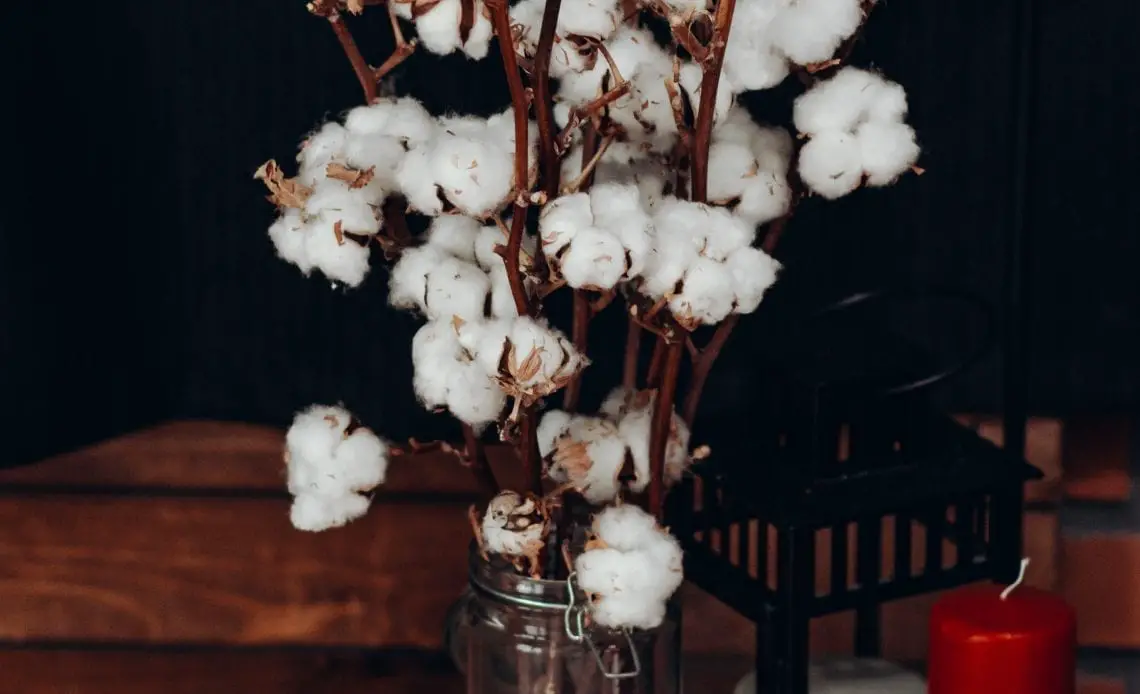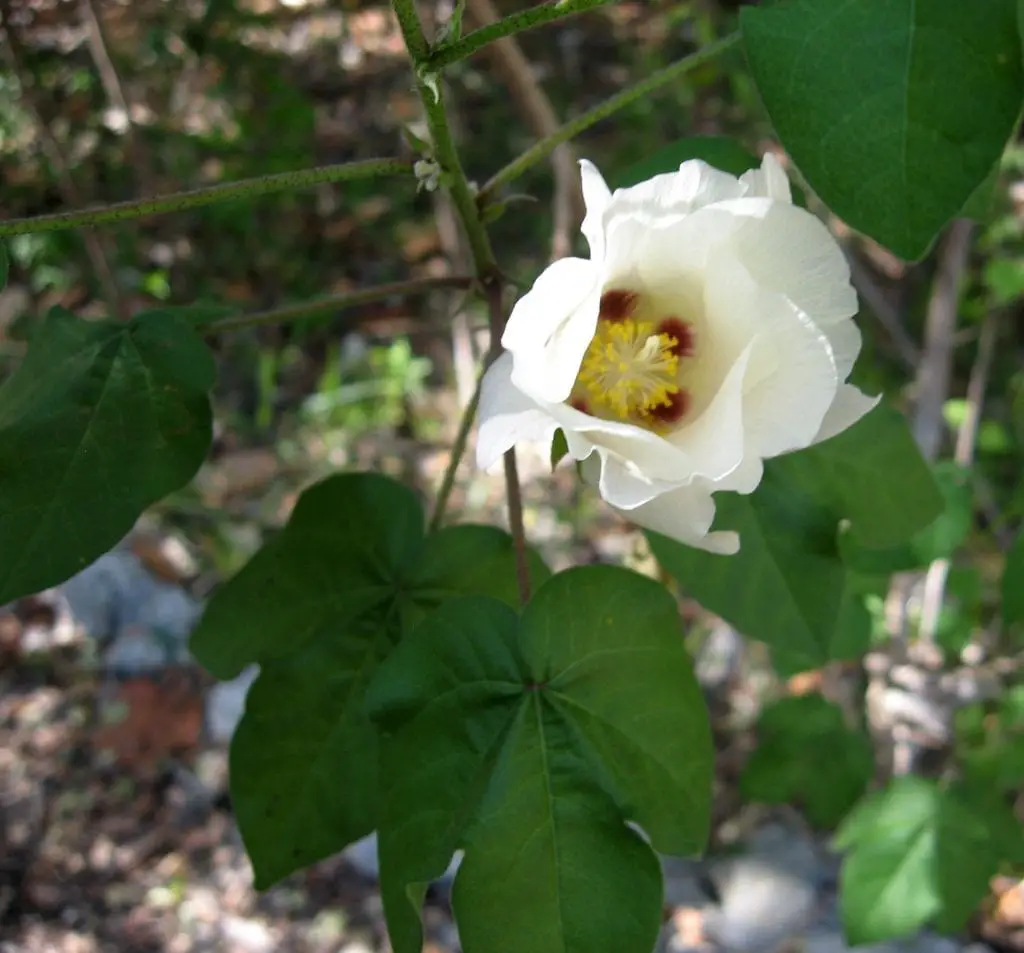
Last updated on May 22nd, 2023 at 03:21 pm
The stunning, albeit uncommon, cotton flower is not a flower at all. Cotton flowers are more like dandelions which hold the seeds of the cotton plant. Once they ‘bloom,’ the cotton flies away, giving the impression that they are all running after each other. Perhaps this is where the meaning of separation and cherishing one another comes from the cotton flower. Not only that, but the cotton flower also is a favored gift to symbolize marriage.
Known as Gossypium, the cotton plant is part of the Mallow family. The name is a derivative of the Arabic word ‘Goz,’ which means a soft substance.’ The word ‘Cotton’ also has Arabic origins and comes from the word ‘Quton’ or ‘Kutun,’ which means ‘fancy fabric.’ Gossypium, or cotton plant, is indigenous to tropical and subtropical regions both in the modern world and in the Ancient days.
Today, cotton is one of the world’s leading crops. This is because cotton is the primary natural fiber used by humans today, and about 80% of the world’s production of natural fibers is incredibly-cotton. In tropical climates, the plant grows up to be treelike- growing up to 20 ft (6.1 m) high and perennial. However, it is a short, shrubby plant growing only around -6 ft (1.83 m) high when cultivated.
The cotton plant is one of the rather exotic origins. The Indus Valley Civilization grew and spun cotton in 3000 BC. Ancient Egyptians living by the Nile wore cotton clothing as well. Eventually, the Arabs brought the plant to Europe around 800 AD via Spain and Sicily. It is here that the name ‘muslin’ came into existence.
When Christopher Columbus discovered America in 1492, he found the plant growing on the Bahama Islands. By the 1500s, cotton was well-known around the world. The cotton plant has been domesticated independently many times in different cultures.
However, none can pinpoint how old cotton truly is. Scientists recently found bits of cotton bolls and cotton cloth in caves in Mexico. These were found to be at least 7,000 years old. Funnily enough, the cotton found was also very close in type to the cotton grown in Modern day America.
What does the Cotton flower symbolize?
The meaning of the cotton flower tends to change from culture to culture; however, the idea of prosperity and family is often found. Well-being and wealth are also associated with the cotton flower across cultures.
In Korea, birth dates are connected with particular flowers and their meaning. In Korean culture, Love of your Mother is one of the most common meanings of the cotton flower. The flower also symbolizes all that is excellent.
In the USA, some people think of the cotton flower as a perfect symbol of a marriage that has stood the test for a few years. Cotton is malleable, soft, and yet incredibly strong. It is seen as a symbol of what a marriage is supposed to be like. Like the cotton flower, marriages must be full of love and yet should be able to go through a whole host of changes. It also symbolizes the urge to follow one another no matter what.
In older Native American traditions, the cotton flower meanings tend towards magic. The cotton flower is seen as a symbol of luck, healing, and protection. Not surprisingly, these meanings are extended to the lives the Native Americans lived. Since cotton requires a very particular rainfall pattern, the Native Americans associate the plant with rain and, eventually, fishing magic.
For the 19th-century Mystic Sri Aurobindo in India, the Cotton flower meaning relates to success in the material world. His metaphysical symbolism of the plant is defined as “the most material vital.” He explains that the flower is a symbol of the physical body. Thus, the flower symbolizes the power of life, growth, and movement. The plant also symbolizes sensitivity to outside impacts. However, according to him, the cotton flower meaning of life and growth means nothing unless offered to the Divine with these meanings in mind.
Meaning of the Cotton flower color
White color

When pollinated, cotton blossoms are all filled with the white balls everyone knows. However, some ornamental variations of the plant are absolute showstoppers.
Mexican cotton is also known as Gossypium Hirsutum or upland cotton, the most commonly planted cotton species. This plant has light pink or snow-white blooms, which look striking amidst the bright green leaves. The white flower tends to have a burgundy print at the center, creating a stunning contrast. Interestingly enough, this variety is also used to produce linseed oil.
Unlike the name suggests, the cotton harvested from Black Cotton is still white. The leaves, however, are striking black or dark purple leaves. This plant is called Levant cotton and is found in sub-Saharan Africa and Arabia. It naturally grows in the wild as a perennial shrub. The flowers grown on this are either hot pink or deep burgundy, creating a stunning contrast.
Interestingly enough, Gossypium Darwinii is called ‘Darwin’s cousin.’ They are a rare find since they grow only on the Galapagos Islands. The flower is a beautiful bright yellow bloom with a contrasting burgundy and orange center.
Interesting facts about the Cotton flowers
- It is not very common to see cotton flowers and plants in dreams. However, if it does turn up, the symbolism is extremely positive. It is said that it is a sign of spiritual awakening. The cotton flower tends to burst open when it’s ripe, so it stands as a symbol of awakening and opening forth to a new world. It is also said to be a symbol of well-being and financial security. This idea possibly harks back to a time in history when cultivating cotton was a lucrative business and was, indeed, the source of financial security for many all over the world.
- However, many also see this as a symbol, not of material wealth, but blessings from the Divine. Spiritually, it is a good time to count your blessings and be thankful for the coming rewards. It is only unfavorable to see the cotton flower in your dreams if they are dirty. This is an indication that things aren’t quite right in life. The cotton flower means there is a time when intelligence and caution must be employed.
- English literature often uses the symbolism of the cotton flower to talk about pastoral peace, simple times, and prosperous ages.
- Walt Whitman mentions the ‘yellow-flowered cotton plant’ in his famous poem, ‘Song of myself.’ He draws up a rather large catalog of images, and the cotton flower turns up to describe a haven. It is a haven where the animals go along with their various tasks, and even the rattlesnake basks in the sun. In this haven, the sugarcane grows, as do the cotton flowers. This starkly contrasts the “sharp-peak’d farmhouse” with its gutters and scum. So for Whitman, too, the meaning of cotton flowers seems the same as we have seen throughout. For him, the cotton flower meaning beauty, divinity, and all that is excellent, stands.
- Another well-known poem about the plant is “November Cotton-flower” by American Poet and Novelist Jean Toomer. In this poem, the cotton flower is growing in a season when it shouldn’t work as a symbol of falsehood, scarcity, and death of the natural world. Toomer explores the trouble of the symbolism of the cotton flower changing during his age. For him, it was a sign of southern natural beauty. However, due to the political changes during his time, he found this pastoral haven transformed into a political and racial contention space. His imagery of the cotton flower is haunting and surreal. However, there is a realization of the objectification of symbols. Some critics think that in this poem, the innocent beauty of the November Cotton flower no longer remains ‘innocent’ when contextualized into history. However, the November cotton represents the sudden, surprising hope for the oppressed. Though it may have lost its ‘pastoral innocence,’ it symbolizes power, prosperity, and well-being.
- The most interesting stories of the cotton flower come from Sir John Manville. He and other medieval writers wrote about a miraculous plant that was a hybrid between an animal and a plant. They thought of the cotton flower as a cross between lambs and plants. Though this sold many travel books, perhaps clinching the market for travel literature, this was far from the truth. As we have seen, cotton flowers existed and were in use far before Sir John Manville came into existence. The Romans spun and wore cotton clothes, the Ancient Indians grew cotton, and so did the ancient Egyptians.
- There are many songs about cotton praising the simple life. However, the numbers reduce to a handful when discussing the cotton flower. However, the meaning of the cotton flower remains more or less the same. Songs written in the modern day and age all still talk about the simple life. The memories of basking in the sun, well-being, and a simple farm life still attach to the little flower.
- The song “Rather Comely,” released in 2020, illustrates this as none other. Cotton flowers drifting past are described as ‘angelic delight.’ The flowers are, predictably, seen on a little road by a brook: all images that hark back to pastoral peace.
- Silence 4’s ‘Ceilings’ sees cotton flowers blossoming, symbolizing hope and well-being amidst the darkness.
- Tanya Tucker’s ‘I Believe The South Is Gonna Rise Again’ is reminiscent of Toomer’s poem. She writes about the cotton flower symbolizing the tired old south. She hopes that happier times when everybody works hand in hand are not far off.
Best time to gift Cotton flowers
The cotton flower’s meaning of overall well-being persists in the modern day and age. It only makes sense that the cotton flower is a great addition to a bouquet when you want to wish someone well. Since it is not only the blooms that are beautiful, the stunning foliage of the plants can be used to create a beautiful arrangement.
In the USA, some people give cotton flowers on their 2nd wedding anniversary. As a gift, it means that the gift giver cherishes the presence of their partner in their life. It also stands as a symbol of what marriage is meant to be: soft, supple, and yet hard enough to weather a million changes to their way of being.
Cotton flowers can be a great gift on Mother’s Day, as they symbolize maternal love’s beauty and softness. In fact, in Korean dramas, they do pop up as a symbol of learning about family and becoming more loving.
Overall, they are the perfect gift for when you want to show appreciation for someone you love. Cotton flowers stand for cherishing those in your life. So anytime you need to show someone that you think the world of them, give them some cotton flowers.
Conclusion
Today, though Egyptian cotton remains well-sought-after, these plants are now grown almost all over the world. They mainly grow in tropical and subtropical areas such as the U.S., China, India, Uzbekistan, Pakistan, Brazil, and Turkey.
The USA is the largest producer of cotton, followed by India and China. Within the United States, Texas is the largest cotton producer. The South Plains region, situated in the northern part of Texas, is the largest cotton-growing area in the world.
If you want to know and learn more about flowers, we at PansyMaiden can help you. Check out our fun, easy-to-read, and informative flower-related content that you will surely enjoy!
